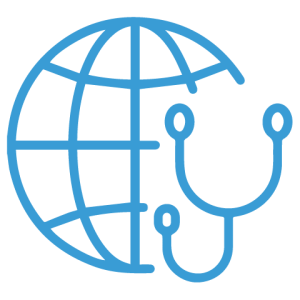The last decade has been marked by significant progress in various fields such as science, medicine, and technology but, at the same time, the number of issues in the world today has steadily grown. In 2020 and 2021, undoubtedly some of the most uncertain and difficult years of the last decade, the biggest problems in the world were the COVID-19 pandemic and poverty. However, the years that followed continued to be somewhat complex and certainly no less easy.
Over the last decade, humanity has lived through a series of negative and dangerous events, with some of the most uncertain and difficult years probably being 2020, 2021, and 2022. The novel coronavirus – COVID-19 – pandemic, constantly increasing poverty and wars erupting in different regions of the world, followed by migration issues, and all of these seasoned with the widening gap between the rich and the poor.
In 2022 – 2025, the war in Ukraine, the Israel – Hamas conflict, and worsening humanitarian crises in many other countries along with the energy crisis and hyperinflation caused multiple economic shocks and stagnation across the continents.
So, what are the most pressing issues in the world today?
As a platform to address global issues that cannot be resolved by any single country, the United Nations organization is spearheading humanity’s struggle to survive. Its most visible efforts concern resolving conflicts and undertaking peacekeeping activities. Below is a list of the world’s greatest, according to the UN.
 Climate Change
Climate Change
There is no economy or individual that is unaffected by climate change. By 2050, this problem could force 216 million people to relocate within their own nations. The changes in weather may worsen water stress and reduce crop output, particularly in the most food-insecure areas of the world.
One of the major problems on our planet is linked to global temperatures that are continually rising. By 2100, studies show that there is a 50% likelihood of facing global warming that is higher than 3.5 degrees Celsius and a 10% probability of witnessing warming higher than 4.7 degrees Celsius relative to temperatures registered between 1850 and 1900. This would result in more severe shifts in weather patterns, food and resource shortages, and the more rapid spread of diseases.
At COP28 in Dubai, held at the end of 2023, the World Bank unveiled ambitious plans to boost climate funding, improve initiatives for carbon markets, and much more.
In 2024, at COP29 held in Baku in Azerbaijan, where almost 200 nations gathered, the attendees agreed a new funding goal aiming to assisting nations to deal with climate disasters as well as to embrace the many advantages of the clean energy revolution. A historic deal was struck to increase funding for poor nations from $100 billion per year to $300 billion per year by 2035.
Experts believe that from 2030 to 2050, the consequences of climate change such as malnutrition, malaria, diarrhea and heat stress will lead to 250,000 more fatalities a year. By 2030, the costs of direct health harm are projected to be between US$2 and US$4 billion annually.
Needless to say, without sufficient support to plan and react, those regions with inadequate health infrastructure, mostly in poor nations, will be least prepared to handle this situation.
Possible solutions:
A reduction in greenhouse gas emissions and increased awareness of the necessity to turn green are among the solutions that can make a significant difference. In addition, strategies to cut carbon emissions and opting for replanting are among the effective ways to address climate change.
 Wars and military conflicts
Wars and military conflicts
Maintaining peace and security is crucial to preventing poverty and high numbers of refugees and asylum seekers. With an increasing number of territories becoming conflict zones, the number of poor and displaced women and children is on rise, causing the spread of diseases and a halt to economic progress.
Preventative diplomacy and demilitarization are the two key tactics for avoiding conflicts. Preventive diplomacy is defined as those actions undertaken to avoid conflicts from forming or worsening. It can also help to limit the spread of existing hostilities. Mediation, conciliation, or negotiation are all options to tackle this world issue.
Sadly, wars and conflicts are at the top of the list of the greatest world issues. 2022 and 2023 were marked by a number of conflicts that led to many casualties and displaced people. The conflicts in many countries, including Ukraine, Palestine, Sudan, Lebanon, and the Democratic Republic of the Congo (DRC) have led to catastrophic events and threatened a massive number of people who have been forced to flee their countries in search of shelter.
Individuals with disabilities and the elderly are the most vulnerable because they may not be able to escape high-risk regions.
Conflict in Ukraine
According to the UN Refugee Agency data (as of February 2025):
- Ukraine has 3.7 million internally displaced people
- Global data shows that there are 6.9 million refugees
- Around 12.7 million people required humanitarian aid, among which 2 million were children
Conflict in Gaza
Data from the United Nations Relief and Works Agency for Palestine Refugees in the Near East (UNRWA) shows that:
- More than 1.9 million Palestinians (over 90% of the population) throughout the Gaza Strip have endured displacement with many facing multiple displacements (at least 10 times).
- Since the ceasefire began, numerous people have attempted to return.
- The Ministry of Public Works and Housing (MoPWH) has stated that 92% of homes have either been completely destroyed or are seriously damaged.
Conflict in Sudan
The data from the United Nations shows that:
- Over 12 million people have been forced to leave their homes since the conflict began in April 2023 with their lives being threatened.
-
- 3 million have settled in neighboring countries (Chad, South Sudan and Egypt).
- 8.4 million have been internally displaced.
-
- More than half of the population is currently experiencing severe hunger as a result of the conflict’s catastrophic effects on food security.
Conflict in Lebanon
The United Nations agencies reported that:
- Around 900,000 individuals have been displaced within Lebanon.
- Around 557,000 people have crossed into Syria, predominantly Syrians who had previously sought refuge in Lebanon.
- From October 8 2023,to September 18, 2024, 50,210 housing units were destroyed or damaged.
- Since 23 September 2024, over 200,000 people have faced displacement
Conflict in the Democratic Republic of the Congo (DRC)
Decades of fighting between the Congolese military and non-state armed groups have resulted in severe violations of human rights, particularly gender-based violence.
The UN Refugee Agency reports that:
- There are 6.4 million internally displaced persons and more than 1 million refugees in nearby nations.
- In the first half of 2024, over 940,000 people were displaced due to escalating conflict in eastern regions.
- A 2024 mpox outbreak has been identified in the country, with possible cases among displaced communities.
Latest refugee data from the UNHCR:
Globally, 122.6 million people were forcibly displaced as of mid-2024 due to persecution, hostilities, violence, abuses of human rights, or incidents that gravely disrupt public order.
Of those millions of people:
- Internally displaced – 68.3M
- Refugees – 37.9M
- Asylum-seekers – 8M
- Other categories that require international assistance – 5.8M
It is significant that 32% of all refugees found shelter in five nations:
- Islamic Republic of Iran – 3.8 million
- Turkey – 3.1 million
- Colombia – 2.8 million
- Germany – 2.7 million
- Uganda – 1.7 million
 Water contamination crisis
Water contamination crisis
One of the most pressing issues in the world today is the lack of access to safe tap water. There is no life without water – apparently a simple truth but one that people seem to overlook. Poor management and irrational use forces communities to migrate in search of drinking water. Industries are polluting underground water and this issue is growing massively.
- Research published in “Science” estimates that 4.4 billion people (over half of the global population) drink contaminated water.
- More than 2 billion people do not have access to clean drinking water in their homes, according to the Centers for Disease Control and Prevention.
- 1.5 billion people lack access to basic sanitary facilities.
- 2 billion people lack access to basic sanitation services.
- Agriculture is responsible for 70% of global water loss.
- Annually, 297,000 children under the age of five die from diarrheal infections caused by poor sanitation, hygiene, or contaminated drinking water.
- 80% of wastewater is discharged into the environment without being processed or reused.
Experts warn that the spread of illnesses such as cholera and typhoid fever is largely caused by poor water quality, lack of sanitation, and poor hygiene.
Possible solutions to the water pollution issue:
The most efficient technique to reduce water pollution is to treat water (filtration, disinfection, etc.) before it reaches the waterway system. Clearing wastewater of pollutants can be performed via biological, physical, and chemical operations.
 Human rights violation
Human rights violation
Human rights are universal, regardless of race, gender, ethnicity, religion, or any other status but what if this only happens on paper?
Indeed, the problems in today’s society are linked with the constant violation of human rights – gender inequality, human trafficking, the lack of freedom of speech – all of these can be witnessed in the 21st century in every country, even in developed nations.
Gender Equality
50% of the world’s population are women and girls. Gender equality is not only a crucial human right; it is also necessary for a peaceful society, the full development of human potential, and long-term evolution.
Possible solutions to gender inequality:
- Speak up for what you believe in
- Pay attention to what others have to say
- Defend yourself from discrimination
- Raise public awareness of a problem
- Get the media to talk about it
- Demonstrate to those in positions of power that they are being watched
 Global health issues
Global health issues
There is no comprehensive list of the top global health challenges because this field is dynamic and ever-evolving. In addition, new threats and hazards related to global health are constantly emerging as seen by the monkeypox outbreak that occurred in 2023. On the other hand, certain global health problems are long-term and may be on the list forever, including cancer, air pollution, and tuberculosis.
Major health problems in the world include:
- Communicable diseases
Influenza outbreaks and COVID-19 are examples of pandemics that highlight our susceptibility to widespread infections, many of which begin in animals. Anxiety and fear are common reactions to pandemics. Other worrisome infectious diseases worth attention are HIV/AIDS, malaria, and Ebola which have remained deadly for decades.
- Environmental factors
Air pollution and climate change have a serious impact on our health. Hurricanes, floods and droughts make disease transmission easier among large populations of people.
- Inequalities and poor healthcare access
Poor access to healthcare, increased infant mortality rates, mainly in low-income nations, and income inequality around the world make it virtually impossible for many families to afford healthcare.
- Political aspects
People become increasingly exposed to diseases as wars within or between countries damage essential infrastructure. As a result, they look for ways to escape the harmful situations that jeopardize their safety but diseases can spread swiftly when people migrate.
- Mental health
A major contributor to disability is depression, and among those aged 15 to 29, suicide caused by depression is the main cause of mortality. Individuals suffering from serious mental health issues frequently encounter stigma, discrimination, and infringements of their human rights which can lead to earlier death. In less severe cases, mental health conditions can impact participation in social activities, close interpersonal connections, and academic or professional performance.
- Noncommunicable diseases (NDCs)
Cancer, heart disease, and diabetes are just a few examples of noncommunicable diseases (NCDs). The risk factors for NCDs include the use of tobacco products and alcohol, obesity, a poor or unbalanced diet, and lack of exercise. Although these global health concerns are present everywhere and are responsible for almost 3 out of every 4 deaths worldwide, low- and middle-income nations make up 77% of NCD deaths.
Possible solutions to global health issues:
- Empower marginalized populations
- Encourage physicians to work in rural regions
- Implement policies that eliminate obstacles and improve access to healthcare
- Promote health breakthroughs (improve research, increase funding)
- Education can help people recognize and improve lifestyle variables such as poor diets, obesity, cigarette use, and alcohol intake which can lead to NCDs.
- Veterinary medicine can enhance global health since diseases originating from livestock play an important role in the spreading of diseases.
 Global poverty crisis
Global poverty crisis
Although there has been a decline in extreme poverty in middle-income nations, poverty in the world’s poorest nations and those impacted by instability, wars, or violence remains higher than it was before COVID-19.
Currently, about 700 million people worldwide face extreme poverty, meaning that their daily income is less than the $2.15 poverty line established by the World Bank. The majority of these individuals reside in sub-Saharan Africa. All in all, the places where it is most difficult to tackle extreme poverty are rural areas and regions impacted by conflicts. It’s worth mentioning that 50% of the people who live in extreme poverty are children.
590 million people could be living in extreme poverty by 2030 if current trends remain, according to the United Nations Statistics Division.
Experts have estimated that just 3 (or fewer) out of 10 nations will be able to reduce their national poverty by half by the end of the decade unless there is a significant acceleration in the process.
Possible solutions to poverty:
- End marginalization by ensuring equality and representation for all
- Provide preventative education and treatment assistance during an epidemic
- Offer recovery interventions during climate disasters
- Help refugees and internally displaced people in terms of health, nutrition, and shelter
- Improve education
- Increase the level of food security and clean water access
- Put an end to conflicts
See also: Absolute poverty vs relative poverty, what is the difference?
 Children’s poor access to healthcare, education and safety
Children’s poor access to healthcare, education and safety
Every child must benefit from the right to proper healthcare, access to education, and grow in safety, and every society benefits from increasing children’s life prospects. Despite this, millions of children worldwide face serious challenges linked with their birthplace, gender, or circumstances.
Over 72 million children around the world who are old enough to attend elementary school are not enrolled. Marginalization and poverty are two major social issues.
Possible solutions to protect children’s rights:
- Encourage education for both children and adults in less developed countries
- Provide clean water
- Ensure basic healthcare
- Tackle gender inequality
- Improve childhood nutrition
 Access to food and the fight against hunger
Access to food and the fight against hunger
By 2030, it is less likely that the world will achieve Sustainable Development Goal 2: Zero Hunger, according to international agencies and media. The situation in countries that have faced food insecurity and where populations suffer from hunger has worsened further as a result of the health and socioeconomic effects of the COVID-19 pandemic.
The global population today exceeds 8 billion people, and there is enough food to feed them all. Based on the most recent State of Food Security and Nutrition in the World (SOFI) report, 733 million people experienced hunger in 2023.
Between 2022 and 2023, hunger worsened in the Caribbean, Western Asia, and the majority of African sub-regions.
If we fail to end extreme poverty, experts anticipate that 582 million people will suffer from chronic undernutrition by 2030, half of whom will be in Africa, according to the World Health Organization.
The same organization has also stated that roughly 2.33 billion people worldwide experienced moderate to severe food insecurity in 2023, with this figure having failed to improve since 2020.
According to the World Food Program, around 9 million people die each year from hunger-related factors – most of them being children aged 5 or younger.
Possible solutions:
- In regions impacted by conflict, humanitarian, development, and peacebuilding initiatives should be rolled out quickly
- The resilience of those who are more prone to economic hardship should be increased
- To reduce the cost of nutritious foods, governments should intervene at various points in the food supply chain
- Deal with poverty by focusing on interventions that help those suffering
- Food environments should be reinforced. In addition, it is important to influence consumer behavior to encourage eating habits that are good for both people and the environment.
- Experts believe that the immediate solution to the food crisis linked to the conflict in Ukraine could be monetary, mainly because of the rising food prices. If governments and donors are able to help people to pay for food, fewer will go hungry.
 Migration
Migration
Massive migration movements impact all UN Member States, necessitating greater collaboration and responsibility-sharing.
The United Nations Member States endorsed the New York Declaration for Refugees and Migrants (A/RES/71/1) wherein they acknowledged that there is a need for a comprehensive strategy for migration. The New York Declaration recognizes the beneficial contributions of migrants to inclusive and sustainable development and pledges to defend their dignity, human rights, and basic freedoms, irrespective of their migration status.
 Weapons accessibility
Weapons accessibility
Multilateral disarmament and armaments restriction are the aims that have been important to the United Nations’ attempts to keep international peace since its inception.
The United Nations has placed a high priority on decreasing and ultimately eliminating nuclear weapons, abolishing chemical weapons, and reinforcing the ban on biological weapons, all of which pose the greatest dangers to humanity.
- A number of multilateral treaties and procedures have been developed as a result of worldwide efforts to regulate, limit, or eliminate specific weapons, including:
- Treaty on the Non-Proliferation of Nuclear Weapons – one of its goals is to stop nuclear weapons and weapons technology from spreading
- Comprehensive Nuclear-Test-Ban Treaty – its goal is to prohibit nuclear weapons trial explosions, as well as any other nuclear explosions
- Biological and Chemical Weapons Convention – forbids biological and toxin weapon manufacturing, procurement, transmission, storage, and use
- Arms Trade Treaty – controls the international conventional armaments trade.
Final word
Although the top 10 global issues certainly help to establish what governments and ordinary people around the world should focus on, there are many other problems that everyone should be aware of, including the aging of population, AIDS, and law and justice. Tackling at least some of these is possible but requires a lot of effort, patience, and understanding.

